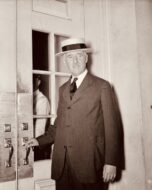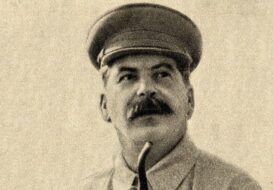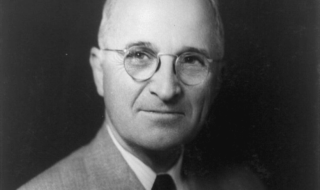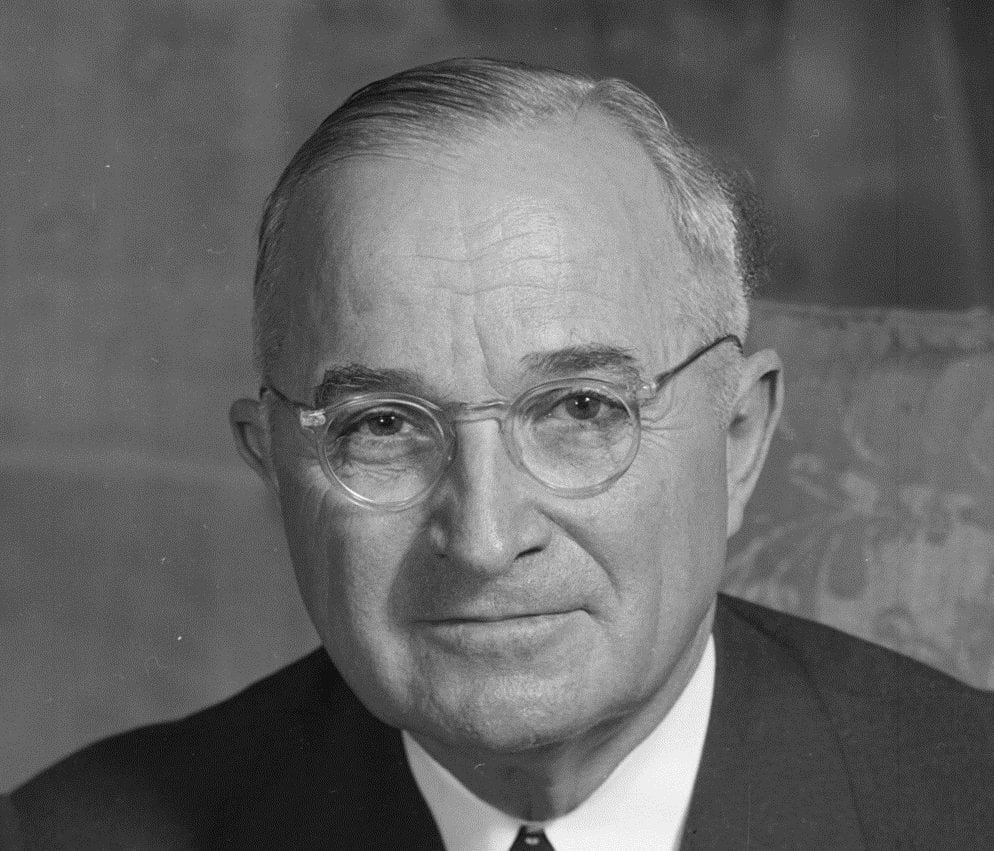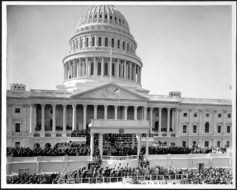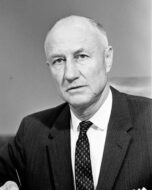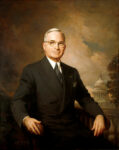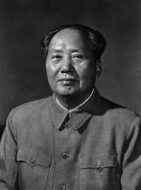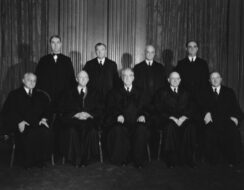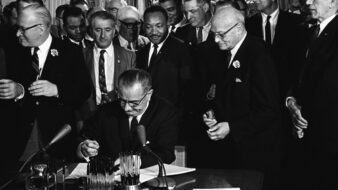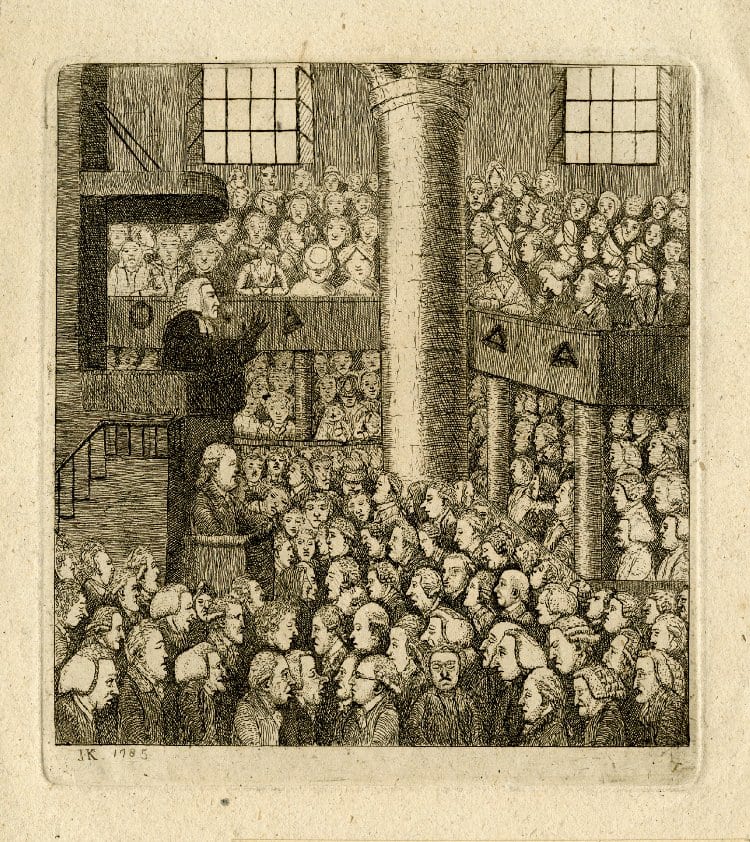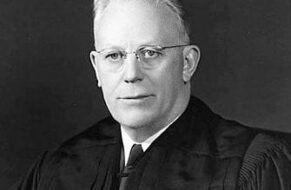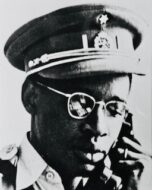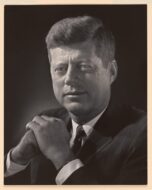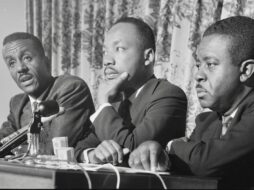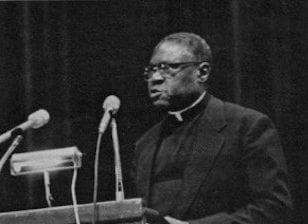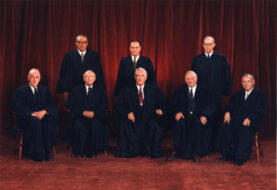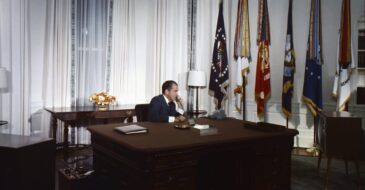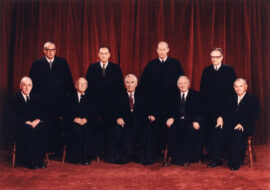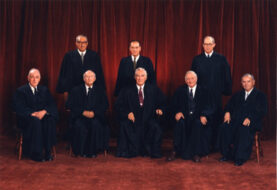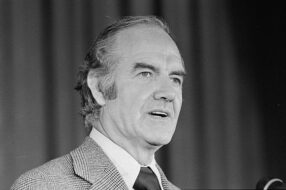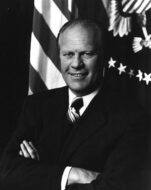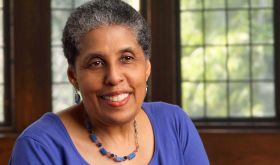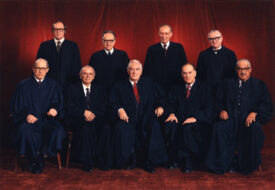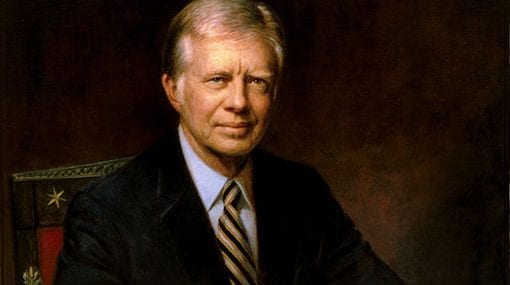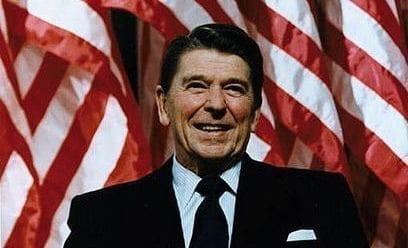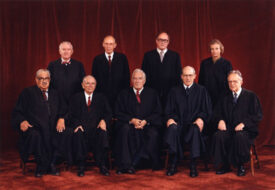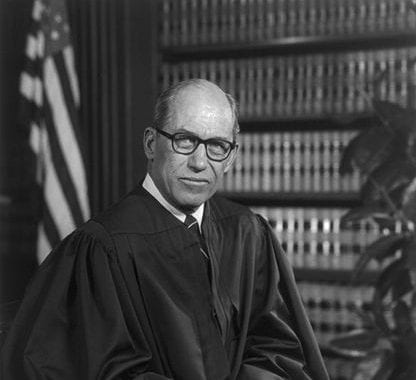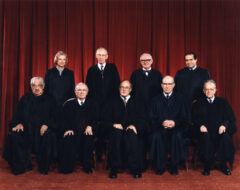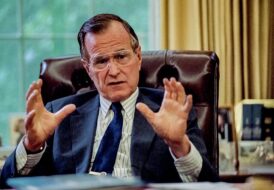

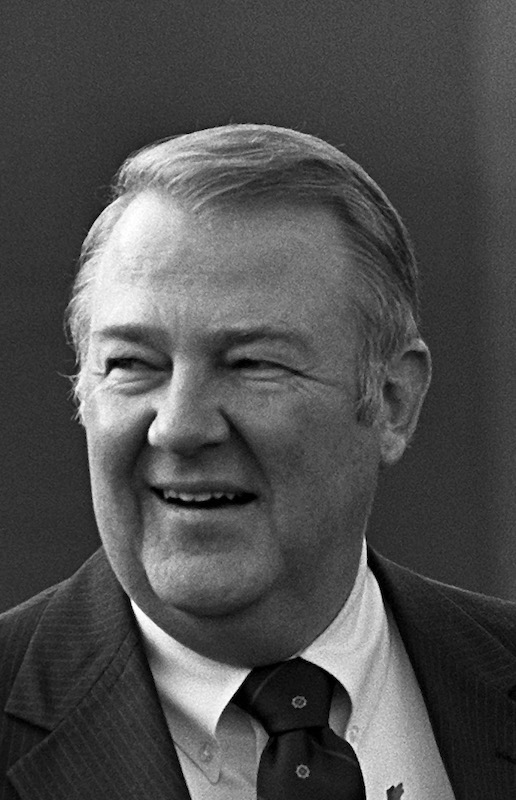
No related resources
Introduction
In a series of three speeches, Ronald Reagan’s attorney general, Edwin Meese (1931– ), helped launch the “originalism revolution.” During the Warren Court era (1953–1969), justices had increasingly argued for a “living” approach to constitutional interpretation. William Brennan (1906–1997), who came to be one of Meese’s harshest critics, had, for instance, said in his opinion in Trop v. Dulles (1958) that when interpreting the Eighth Amendment justices “must draw its meaning from the evolving standards of decency that mark the progress of a maturing society.” Other justices, such as William O. Douglas (1898– 1980) in Griswold v. Connecticut (1965), had announced previously unrecognized rights such as a general right to privacy because “specific guarantees in the Bill of Rights have penumbras, formed by emanations from those guarantees that help give them life and substance.”
For Meese, this kind of reasoning simply allowed justices to do what Brutus had predicted they would do: interpret the Constitution according to its “spirit” rather than its actual text. Meese argued for what he called a Jurisprudence of Original Intention that would bind judges to the original meaning of the text—what the words meant when they were written. In this speech, Meese looked at several areas of constitutional law such as federalism, criminal law, and religion where he thought the Court had abandoned the original understanding of the Constitution. The Constitution, according to originalists like Meese, is a contract whose terms cannot be redefined except through the amendment process. Ultimately for Meese, originalism seemed to be the only way to reconcile judicial power with principles of self-government.
Originalism initially came under significant attack and was dismissed as the position of disaffected conservatives. For instance, during the Senate Judiciary Committee hearings for his failed nomination to the Supreme Court (1987), Robert Bork’s originalism was a primary point of attack. Originalism, however, has gained wider acceptance across the ideological spectrum. Leading liberal constitutional scholars such as Jack Balkin and Akhil Amar of Yale Law School are both self-professed originalists. Perhaps most tellingly, during her 2010 nomination hearings, Justice Elena Kagan (1960–) said that in some ways “we are all originalists.”
Source: Edwin Meese III, “Speech to the American Bar Association,” Washington, D.C., July 9, 1985, U.S. Department of Justice, https://www.justice.gov/sites/default/files/ag/legacy/2011/08/23/07-09-1985.pdf.
. . .In looking back over the work of the Court, I am again struck by how little the statistics tell us about the true role of the Court. In reviewing a term of the Court, it is important to take a moment and reflect upon the proper role of the Supreme Court in our constitutional system.
The intended role of the judiciary generally and the Supreme Court in particular was to serve as the “bulwarks of a limited constitution.” The judges, the Founders believed, would not fail to regard the Constitution as “fundamental law” and would “regulate their decisions” by it. As the “faithful guardians of the Constitution,” the judges were expected to resist any political effort to depart from the literal provisions of the Constitution. The text of the document and the original intention of those who framed it would be the judicial standard in giving effect to the Constitution.
You will recall that Alexander Hamilton, defending the federal courts to be created by the new Constitution, remarked that the want of a judicial power under the Articles of Confederation had been the crowning defect of that first effort at a national constitution. Ever the consummate lawyer, Hamilton pointed out that “laws are a dead letter without courts to expound and define their true meaning.”1
The Anti-Federalist Brutus took him to task in the New York press for what the critics of the Constitution considered his naiveté. That prompted Hamilton to write his classic defense of judicial power in Federalist 78.2
An independent judiciary under the Constitution, he said, would prove to be the “citadel of public justice and the public security.” Courts were “peculiarly essential in a limited constitution.” Without them, there would be no security against “the encroachments and oppressions of the representative body,” no protection against “unjust and partial” laws.3
Hamilton, like his colleague Madison, knew that all political power is “of an encroaching nature.” In order to keep the powers created by the Constitution within the boundaries marked out by the Constitution, an independent—but constitutionally bound—judiciary was essential. The purpose of the Constitution, after all, was the creation of limited but also energetic government, institutions with the power to govern, but also with structures to keep the power in check. As Madison put it, the Constitution enabled the government to control the governed, but also obliged it to control itself.
But even beyond the institutional role, the Court serves the American republic in yet another, more subtle way. The problem of any popular government, of course, is seeing to it that the people obey the laws. There are but two ways: either by physical force or by moral force. In many ways the Court remains the primary moral force in American politics.
Tocqueville put it best:
The great object of justice is to substitute the idea of right for that of violence, to put intermediaries between the government and the use of its physical force . . .
It is something astonishing what authority is accorded to the intervention of a court of justice by the general opinion of mankind . . .
The moral force in which tribunals are clothed makes the use of physical force infinitely rarer, for in most cases it takes its place; and when finally physical force is required, its power is doubled by his moral authority.
By fulfilling its proper function, the Supreme Court contributes both to institutional checks and balances and to the moral undergirding of the entire constitutional edifice. For the Supreme Court is the only national institution that daily grapples with the most fundamental political questions—and defends them with written expositions. Nothing less would serve to perpetuate the sanctity of the rule of law so effectively.
But that is not to suggest that the justices are a body of Platonic guardians. Far from it. The Court is what it was understood to be when the Constitution was framed—a political body. The judicial process is, at its most fundamental level, a political process. While not a partisan political process, it is political in the truest sense of that word. It is a process wherein public deliberations occur over what constitutes the common good under the terms of a written constitution.
As a result, as Benjamin Cardozo pointed out, “the great tides and currents which engulf the rest of men do not turn aside in their course and pass the judges by.”4 Granting that, Tocqueville knew what was required.
As he wrote:
The federal judges therefore must not only be good citizens and men of education and integrity, . . . (they) must also be statesmen; they must know how to understand the spirit of the age, to confront those obstacles that can be overcome, and to steer out of the current when the tide threatens to carry them away, and with them the sovereignty of the union and obedience to its laws. . . .
In my opinion a drift back toward the radical egalitarianism and expansive civil libertarianism of the Warren Court would once again be a threat to the notion of limited but energetic government.
What, then, should a constitutional jurisprudence actually be? It should be a Jurisprudence of Original Intention. By seeking to judge policies in light of principles, rather than remold principles in light of policies, the Court could avoid both the charge of incoherence and the charge of being either too conservative or too liberal.
A jurisprudence seriously aimed at the explication of original intention would produce defensible principles of government that would not be tainted by ideological predilection.
This belief in a Jurisprudence of Original Intention also reflects a deeply rooted commitment to the idea of democracy. The Constitution represents the consent of the governed to the structures and powers of the government. The Constitution is the fundamental will of the people; that is why it is the fundamental law. To allow the courts to govern simply by what it views at the time as fair and decent is a scheme of government no longer popular; the idea of democracy has suffered. The permanence of the Constitution has been weakened. A Constitution that is viewed as only what the judges say it is, is no longer a constitution in the true sense.
Those who framed the Constitution chose their words carefully; they debated at great length the most minute points. The language they chose meant something. It is incumbent upon the Court to determine what that meaning was. This is not a shockingly new theory; nor is it arcane or archaic.
Joseph Story, who was in a way a lawyer’s everyman—lawyer, justice, and teacher of law—had a theory of judging that merits reconsideration.5
Though speaking specifically of the Constitution, his logic reaches to statutory construction as well.
In construing the Constitution of the United States, we are in the first instance to consider, what are its nature and objects, its scope and design, as apparent from the structure of the instrument, viewed as a whole and also viewed in its component parts. Where its words are plain, clear, and determinate, they require no interpretation. . . . Where the words admit of two senses, each of which is conformable to general usage, that sense is to be adopted, which without departing from the literal import of the words, best harmonizes with the nature and objects, the scope and design of the instrument.6
A Jurisprudence of Original Intention would take seriously the admonition of Justice Story’s friend and colleague, John Marshall, in Marbury that the Constitution is a limitation on judicial power as well as executive and legislative. That is what Chief Justice Marshall meant in McCulloch when he cautioned judges never to forget it is a constitution they are expounding.7
It has been and will continue to be the policy of this administration to press for a Jurisprudence of Original Intention. In the cases we file and those we join as amicus, we will endeavor to resurrect the original meaning of constitutional provisions and statutes as the only reliable guide for judgment. . . .
We will pursue our agenda within the context of our written Constitution of limited yet energetic powers. Our guide in every case will be the sanctity of the rule of law and the proper limits of governmental power.
It is our belief that only “the sense in which the Constitution was accepted and ratified by the nation,”8 and only the sense in which laws were drafted and passed provide a solid foundation for adjudication. Any other standard suffers the defect of pouring new meaning into old words, thus creating new powers and new rights totally at odds with the logic of our Constitution and its commitment to the rule of law.
- 1. Alexander Hamilton, Federalist 22.
- 2. Brutus XV and Federalist 78.
- 3. Federalist 78.
- 4. Benjamin Cardozo (1870–1938) was a justice of the Supreme Court. The quotation is from Benjamin N. Cardozo, The Nature of the Judicial Process (New Haven: Yale University Press, 1921), 168.
- 5. Joseph Story (1779–1845) was a justice of the Supreme Court.
- 6. Joseph Story, Commentaries on the Constitution of the United States (Boston: Little, Brown, 1873), 297
- 7. Marbury v. Madison and McCulloch v. Maryland.
- 8. James Madison to Henry Lee, June 25, 1824, https://founders.archives.gov/ documents/Madison/04-03-02-0333.

Conversation-based seminars for collegial PD, one-day and multi-day seminars, graduate credit seminars (MA degree), online and in-person.

